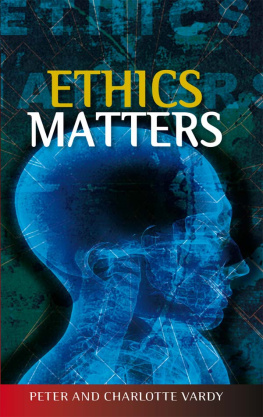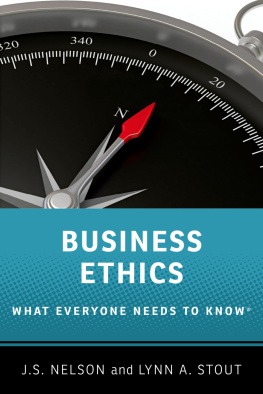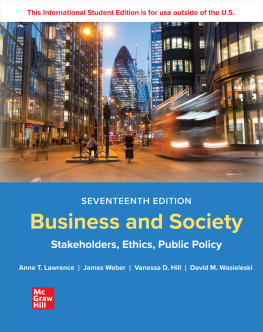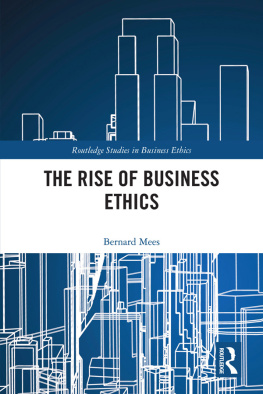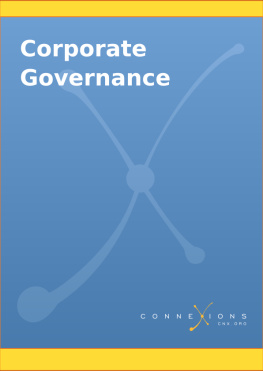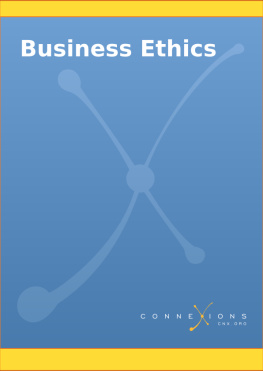BUSINESS ETHICS

1
Write a review to receive any free eBook from our Catalog - $99 Value!
If you recently bought this book we would love to hear from you! Benefit from receiving a free eBook from our catalog at hSHp://www.emereo.org/ if you write a review on Amazon (or the online store where you purchased this book) about your last purchase!
How does it work?
To post a review on Amazon, just log in to your account and click on the Create your own review buSHon (under Customer Reviews) of the relevant product page. You can find examples of product reviews in Amazon. If you purchased from another online store, simply follow their procedures.
What happens when I submit my review?
Once you have submiSHed your review, send us an email at with the link to your review, and the eBook you would like as our thank you from hSHp://www.emereo.org/ . Pick any book you like from the catalog, up to $99 RRP. You will receive an email with your eBook as download link. It is that simple!
2
NoOce of Rights
All rights reserved. No part of this book may be reproduced or transmiSHed in any form by any means, electronic, mechanical, photocopying, recording, or otherwise, without the prior wriSHen permission of the publisher.
NoOce of Liability
The informaOon in this book is distributed on an "As Is" basis without warranty. While every precauOon has been taken in the preparaOon of the book, neither the author nor the publisher shall have any liability to any person or enOty with respect to any
loss or damage caused or alleged to be caused directly or indirectly by the instrucOons contained in this book or by the products described in it.
Trademarks
Many of the designaOons used by manufacturers and sellers to disOnguish their products are claimed as trademarks. Where those designaOons appear in this book, and the publisher was aware of a trademark claim, the designaOons appear as requested by the owner of the trademark. All other product names and services idenOfied throughout this book are used in editorial fashion only and for the benefit of such companies with no intenOon of infringement of the trademark. No such use, or the use of any trade name, is intended to convey endorsement or other affiliaOon with this book.
3
Contents
1. BASICS 7
2. FUNDAMENTALS 15
3. CONCEPTS 24
4. UNDERSTANDING BUSINESS ETHICS 29
5. MANAGING BUSINESS ETHICS 36
6. PERFORMANCE, PRINCIPLES & PEOPLE 42
7. DECISION MAKING 46
8. SOCIAL RESPONSIBILITY 55
9. ETHICS AND SOCIAL RESPONSIBILITY 62
10. METHODOLOGIES FOR ADDRESSING ETHICAL PROBLEMS 69
11. SUPPORTING DOCUMENTS 79 a. GUIDELINES TO BUSINESS ETHICS 81 b. BUSINESS ETHICS, CONDUCT, AND LEGAL COMPLIANCE 97 c. ACME COMPANY, INC. BUSINESS ETHICS POLICY AND PROCEDURES 107 d. CODE OF BUSINESS ETHICS FOR DIRECTORS 131 e. INSTITUTE FOR BUSINESS AND PROFESSIONAL ETHICS 135
12. GLOSSARY 181
5
1. BASICS
This secOon looks at some of the basics of business ethics and discusses answers to the following quesOons.
Who is responsible for ensuring businesses are ethical and why?
?? Government?
?? Society?
?? Business?
What is an ethical business?
There is no exact scienOfic or mathemaOc answer to this quesOon.
A textbook definiOon describes business ethics as a concern with good and bad (or right and wrong) behavior and pracOces that take place within a business context.
The term 'ethics' shares a similar definiOon but requires the addiOonal aspect of moral obligaOon and duty.
7
THREE MAJOR APPROACHES TO THINKING ABOUT BUSINESS ETHICS
Businesses use the following three major approaches when thinking about business ethics.
The convenOonalist approach
This approach involves a comparison between a decision or pracOce and the prevailing norms of acceptability. These norms arise from a variety of sources, including personal (family and friends), organizaOonal (employer and profession), social (society at
large), and internaOonal (regions of country). The following diagram shows how the convenOonalist approach works.

8
The convenOonalist approach views the law as the minimum requirement and sees ethics as a standard that should exceed this minimum.
Ethical relaOvism is a pinall of this approach; good, bad, right and wrong are relaOve to the normal behavior and beliefs of society.
The principles approach
This approach involves applying a concept, guideline, or rule to an ethical dilemma. The aim of these principles is to assist in making ethical decisions.
Various principles exist today, including:
UOlitarianism: Greatest good for all
Categorical imperaOve: Good faith effort to do the right thing
Virtue ethics: Focus on the individual
Servant leadership: Serve others first
Disclosure rule: What if the decision was made public?
The golden rule: Do unto others as you would have them do unto you
The ethics test approach
This approach uses six elements to assist in making an ethical decision.
The test of common sense: Does the acOon make sense?
The test of your best self: Does this acOon represent my best self?
The test of making something public: How would I feel if others knew what I was doing?
The test of venOlaOon: Seek other's views, especially those who are likely to disagree with the proposed acOon.
The gag test: A natural response to something that goes against your beSHer judgment.
The test of the purified idea: The purified idea oOen leads to a common ethical error where an acOon becomes purified (made right) when a superior supports it. This test is important to prevent this common error.
None of these tests are fool proof; however, they can help lead to beSHer ethical decision-making.
INFLUENCIAL FACTORS
A variety of factors can influence how individuals and businesses approach ethics. The following tables demonstrate the different influenOal factors within these two areas.
Factors that influence the individual
Region of country
Faith/Religious beliefs
Factors that influence the business
MAINTAINING AN ETHICAL STANDARD
Code of ethics
Maintaining a code of ethics is important because it:
?? protects the firm;
?? increases firm loyalty and trust;
?? increases consumer good will;
?? improves performance;
?? reduces bribery and kickbacks*;
?? reduces conflicts of interest; and
?? reduces discriminaOon.
*Foreign Corrupt PracOces Act of 1977
Berkshire Hathaway's code of ethics provides a useful example:
?? Warren Buffet hSHp://www.precisionsteel.com/about/conduct.asp
Useful methods
The following methods can assist companies in maintaining an ethical standard:
?? Ensuring wriSHen codes exist of all policies and guidelines
Next page


